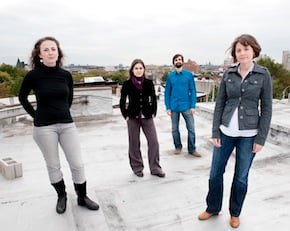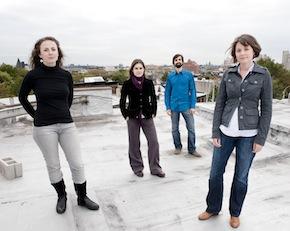
Tucked between the teal-painted Highway 101 skyway and the bizarre former Armory in the no-man’s land between the Mission District and Civic Center is the Brick and Mortar Music Hall. Formerly known as the CODA Jazz Supper Club (which recently went out of business), the venue hosts a variety of independent bands and strikes a typically “Mission” balance between grungy underground and swanky style. Last Thursday, the Redshift Ensemble and Jack O’ The Clock presented a doubleheader, attracting a young crowd that sat on bar stools, at tables, or on the floor, listening to the music while sipping drinks.
Redshift premiered the “Arctic Sounds” project Wednesday in New York and will go on tour to Alaska next spring. The ensemble consists of Andie Springer on violin, Jeffrey Anderle on clarinet, Rose Bellini on cello, and Kate Campbell on piano — an instrumentation that inescapably evokes Messiaen’s Quartet for the End of Time. The group seems well connected to the northern sphere, both in terms of the Arctic world’s timeless stillness and in the project’s use of bird sounds and other nature sounds, which Messiaen also incorporated.
The program consisted of 10 short pieces (or movements), each a premiere by a different composer, played without pause to form one large, crowd-sourced composition. Each movement used a track from Kathy Turco’s recordings of natural sounds from the Arctic, played simultaneously with the live music.
Nature’s sounds are undoubtedly musical: the call and response of birds, moose, bears, wolves; the sounds of winds, rivers, people, and machines, all of which create an endless symphony. In the Arctic, where nature’s sounds haven’t yet been entirely drowned out by humankind’s cacophony, the conversations of the animals and elements is particularly striking. So, how do musicians and composers combine their craft with recordings of nature’s song?
Different Strokes for Different Folks
The 10 featured composers (Jad Abumard, Ryan Brown, Garrett Byrnes, Richard Carrick, James Holt, Mary Kouyoumdjian, David Lang, Max Stoffregen, Kirsten Volness, and Matthew Welch) took various approaches. Some stayed out of the way, responding where the recordings allow for gaps. Others joined in the conversation, with imitations of bird calls in the violin and piano, or reacting to moose bellows with groans in the cello. Others went off on other paths, inspired by the music to a certain mood or compositional premise while the Arctic chirped and howled in the background. All these approaches are worthy, and contributed to the richness of the presentation, yet the most effective moments occurred when sound events in the recording triggered a response in the instruments that was not merely a rough imitation of the pitches and rhythm but also a feedback in character and emotion. Only rarely was the passion of the polar winds or the wolves matched by the composers and performers.
Nature’s music is uninhibited, raw, and passionate; written compositions are refined, structured, and metered. Despite the variety of composers and approaches, the ensemble kept a unified sound for the entire performance, owing to a selection of like-minded composers and the artful curating of different voices and tempers side by side. The flow of the entire program was propelled by a simple San Francisco minimalism and a postmodern attitude to dissonance, harmony, melody, and rhythm. Everything was on the table; complete dissonance was as welcome as triads, steady pop rhythms as common as rhythmically nebulous sections.
The program’s two most memorable movements were Lang’s Stick Figure With Seabirds Mural, which had the cello and clarinet holding long, suspended tones with icy patience while the violin and piano hacked away intermittently like aggressive seagulls. The violinist doubled as percussionist on bass drum and cake pan. It was a strange yet effective piece, very fitting with the Arctic theme even though it was a recycled arrangement of a previous piece about young children growing up, and skeletons. It is always amazing to hear how the same piece of music can work in different mental contexts.
Another work, Jad Abumard’s untitled sound collage, was also effective, not only for the sheer contrast of presentations (the live musicians sat this one out), but also for the distances to which Abumard took Turco’s recordings: Sounds were sped up, slowed down, spun around, stripped to their sound-wave building blocks, creating music vastly different from everything else on the program. The placement of Untitled at the heart of the lineup, sandwiched by instrumental pieces, contributed to the piece’s striking balance. From where I was sitting, it seemed that the sound system was not doing justice to the piece or the original recordings.
After an intermission, Jack O’ The Clock, a difficult-to-define band that includes five musicians (Damon Waitkus, Emily Packard, Kate McLoughlin, Jason Hoopes, Jordan Glenn) playing 18 instruments (voices, guitar, hammered dulcimer, five-string and baritone violins, banjo, melodica, bassoon, flute, glockenspiel, bass, piano, drums, percussion, and accordion), performed what they call “Majestic junk folk”: an excellent description. The band’s best asset is its wealth of good instrumental lines, which helps Jack stand out in the Mission’s crowded singer/songwriter scene. In an emerging category that is buzzing around, Jack could also be characterized as “Chamber Pop” — a rock band that adds classically trained musicians to guitar, drums, and amplified vocals. The musicians are adventurous conservatory graduates who explore this route alongside scarce classical orchestra gigs.
While Redshift and Jack O’ The Clock represent entirely different styles, they complemented each other on the program and combined at the end for Novaya Zemlaya: The large ensemble set a sonic backdrop, while Waitkus told a story about an island north of Russia. The entire evening was another promising example of the blurring of lines between musical styles: classical, academic, popular, live, and electronic.

